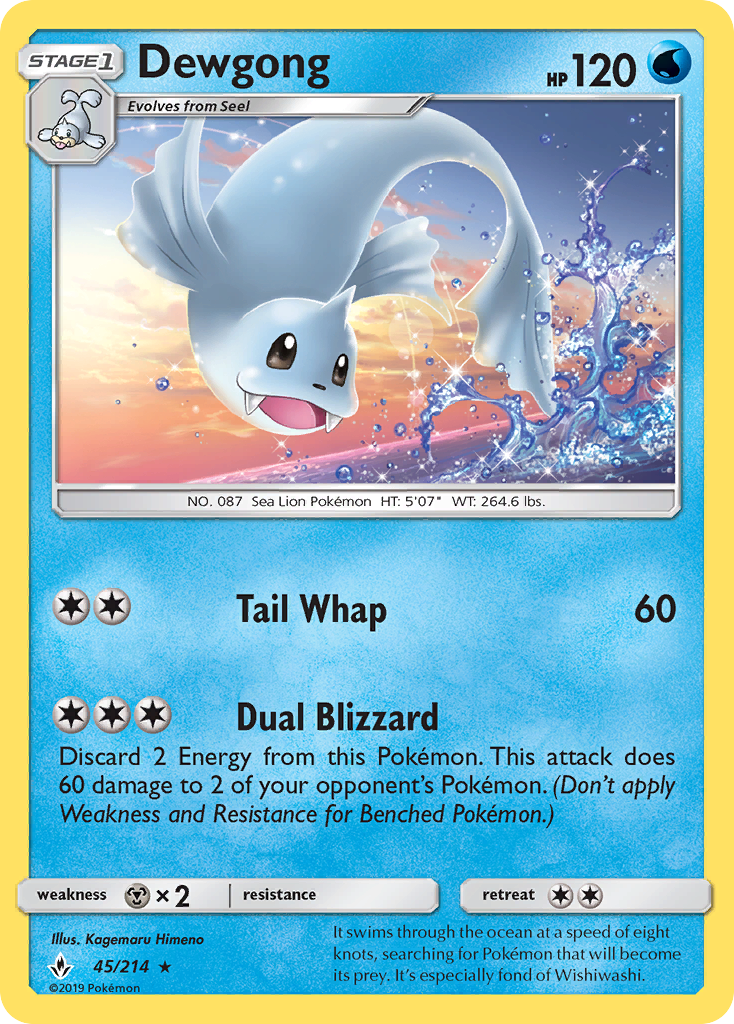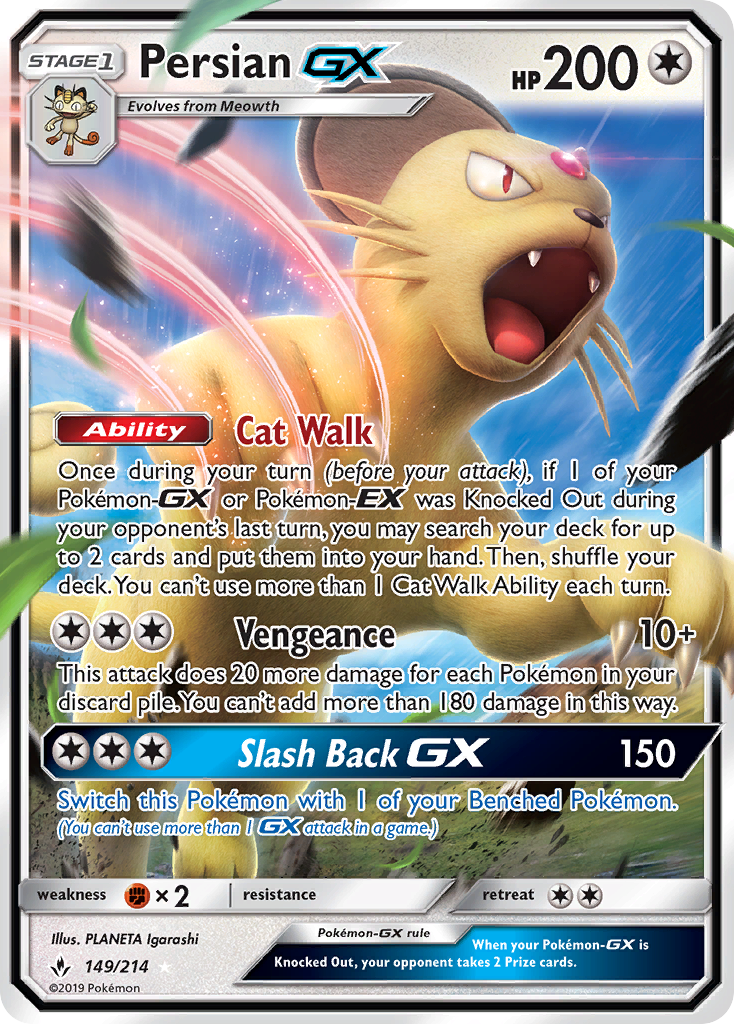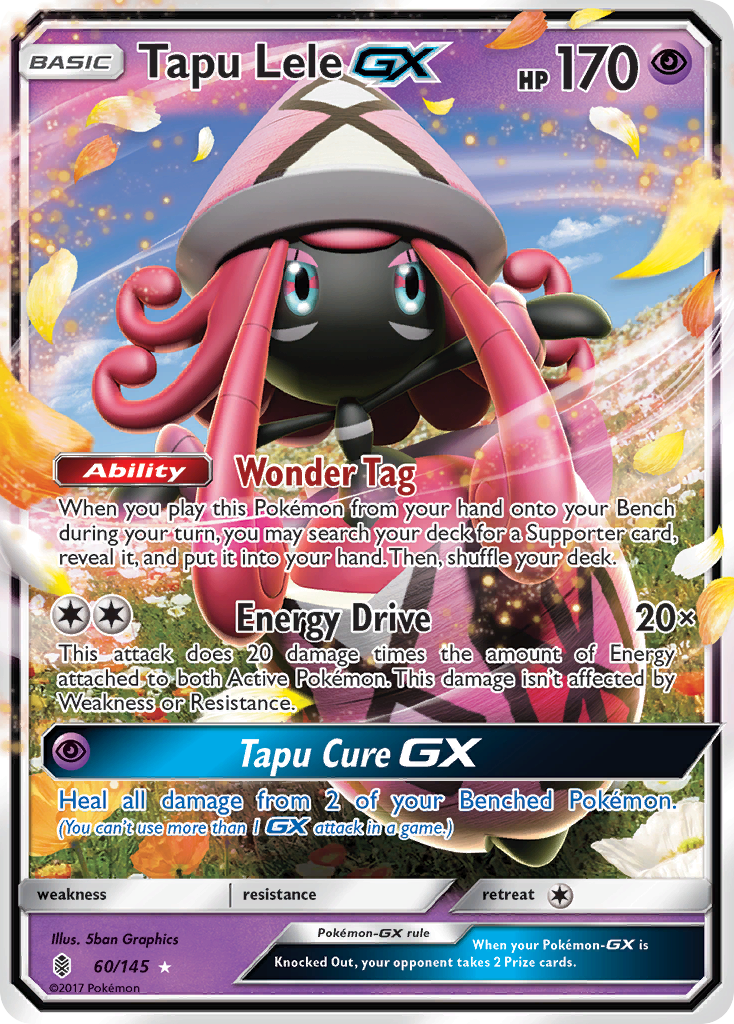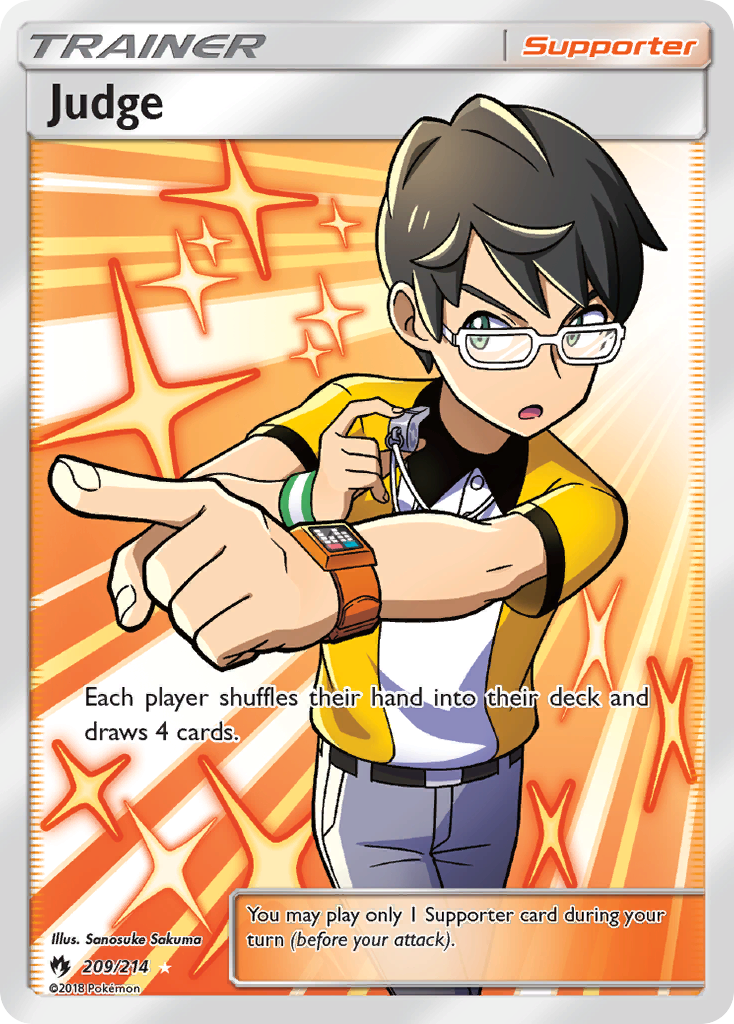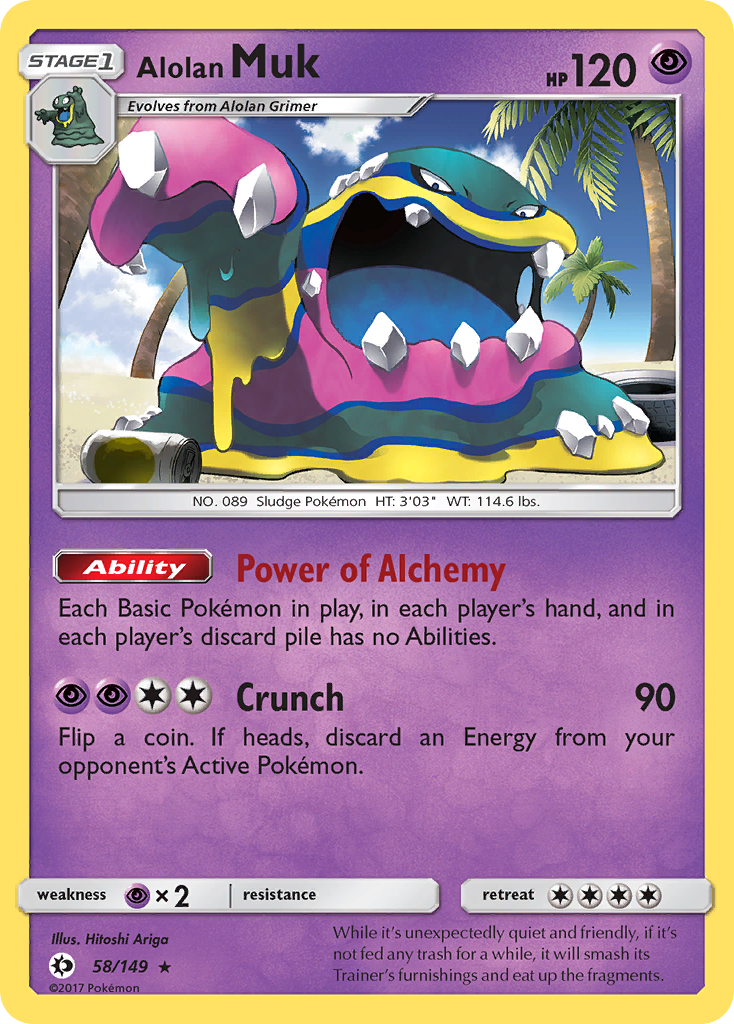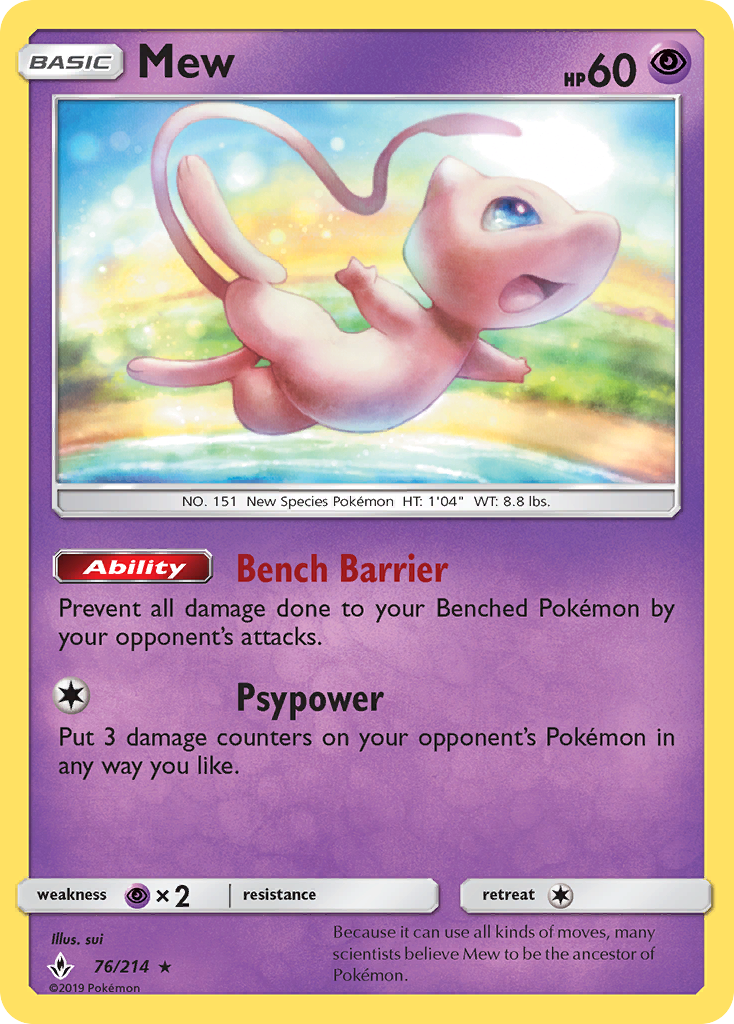Zoroark’s Last Stand — Zoroark-GX / Dewgong for NAIC
Hello! As I’m writing this, I’m sitting in the central bus station in Jonköping, Sweden, where I just got top 8 at the last European Regionals of the season. I’ll soon be departing for a series of flights to Columbus, Ohio, to compete in the biggest even of the year, the North American International Championships, where I’ll be defending my title. Despite the circumstances, I’m determined to provide you with the best content I can, and the best content I can provide right now is a complete guide to Zoroark-GX / Dewgong.
I’ve switched decks around a lot this year — in the Team Up format, for example, I played Zoroark-GX / Lycanroc-GX / Lucario-GX, Malamar / Ultra Necrozma-GX, Pikachu and Zekrom-GX, Zapdos /
, and Zapdos / Ultra Beasts, hopping from one deck to another every week or so. However, since Unbroken Bonds released, I’ve been a one-trick pony. I fell in love with Zoroark-GX / Dewgong early on and played literally nothing else at official events. So far, out of the four tournaments I’ve played with it, I won three (two League Cups and a League Challenge) and made top 8 at the last (the aforementioned Jonköping Regionals), proving its strength in a more competitive environment. All in all, you’ll easily understand that I feel confident with the deck. I’m not the only one who believes in it, either: fellow Zoroark-GX addict Henry Brand won the New Zealand SPE with Zoroark-GX / Dewgong last weekend, and the deck has been popping up at Cups here and there. It is the deck I’m most likely to play at NAIC, although with one week of intensive training left, I can’t exclude the possibility of switching to something else.
That said, Zoroark-GX / Dewgong doesn’t have the same popularity as, and isn’t perceived to be as strong as, other archetypes like Reshiram and Charizard-GX or Pikachu & Zekrom-GX. It’s not even the most feared Zoroark-GX variant! I believe this is because the deck is hard to play, especially against some common matchups. This is why I’m writing this guide, in the hopes it can help some of you understand how the humble Dewgong can be as fearsome as, if not more than, bigger Pokemon such as Silvally-GX.
1. Everything is Situational
I’ve received many questions from strangers about this deck, asking why I included a specific card or excluded one, or how to play a certain matchup. "Do I always set up Dewgong? If so, do I always set up Alolan Muk alongside it to prevent issues with Mew? Should Double Colorless ever be discarded with Trade?" And so on.
Here’s a catch-all answer: Everything in this deck is situational. Sure, you’ll need to set up Zoroark-GX pretty much all the time, but, beyond that, everything varies from matchup to matchup and even from game to game. Sometimes you’ll win games attacking with nothing but Dewgong, even using its first attack -- sometimes you’ll never bench a Seel. Sometimes you’ll attack with Tapu Lele-GX; sometimes you can afford to discard your whole hand to take a precious KO; sometimes you need to keep Persian-GX in hand for the most opportune moment; and sometimes you should play it down as soon as possible and use Slash Back GX for an early KO. I can’t teach you how to approach every single situation, so although I’ll do my best to guide you through the deck’s matchups, when in doubt, you need to have a general idea of what your opponent can do and what the consequences of each of your possible plays can be.
Here’s an example: The deck plays 1-1 Persian-GX. Should you set it up?
First of all, it depends on the matchup, of course. Against Weezing, for example, Persian-GX is almost useless. Both its attacks are unnecessary when Zoroark-GX gets KOs just as easily on Weezing but doesn’t need a Triple Acceleration Energy, and has more HP and a Psychic Resistance. Cat Walk, Persian-GX’s other use, is not very relevant either, for two reasons. First, Weezing tends to take Prizes against low-HP Pokemon first, so if a Pokemon-GX gets Knocked Out, it would be late in the game, when you generally have all the cards you need thanks to repeated Trade and don’t need the to search for cards with Cat Walk. Second, there’s a chance that Weezing doesn’t even activate Cat Walk anyway. For example, they could use Tapu Lele’s Magical Swap to put 20 damage counters on Zoroark-GX, letting it be Knocked Out by Shrine of Punishment. In this case, Cat Walk wouldn’t be active and having another Zoroark-GX in Persian-GX’s place would be much better.
In most other matchups, especially those where Zoroark-GX can be OHKO’d, Persian-GX is a great asset.
Still, even if you know you’re eventually going to use Persian-GX, that doesn’t mean you need to set it up too soon! Given equal opportunity, a good opponent will always choose to KO Persian-GX instead of Zoroark-GX. Often, it’s better to keep Meowth on the Bench and Persian-GX in your hand, only evolving it when you need to use Cat Walk or attack with Persian-GX. That way, your opponent needs to choose between a KO on Zoroark-GX or a KO on Meowth, which prevents a Cat Walk retaliation but only gives up one Prize card. You can even keep both Ditto Prism Star and Meowth in play unevolved so that you can set up Persian-GX regardless of which Pokemon is Knocked Out.
There’s a catch, though: what if your opponent uses Let Loose and KOs Zoroark-GX? Then you won’t have Persian-GX in hand anymore and you can’t use Cat Walk.
And there are still other factors to keep in mind. For example, if you’re playing against Zapdos / Ultra Beasts, playing Persian-GX down means giving your opponent’s Nihilego better attacks to use. Depending on your board and the number of Pokemon in your opponent’s discard, it can be harmless or a huge risk. For example, if you have a Tapu Lele-GX on the Bench, your opponent can now attach a Beast Energy Prism Star or Choice Band to Nihilego and use Slash Back GX for two Prizes.
As you may have gathered by now, there’s no easy answer, even in a given matchup. You need to understand your options — do you need Persian-GX to take a KO or can you attack with something else? Are you confident you have enough Zoroark-GX on board and Pokemon-searching cards left to find Persian-GX if it gets shuffled into your deck by Let Loose? Is it possible for your opponent to KO Persian-GX or Meowth? Is it even likely that they have Guzma? There’s no magical formula that says in which proportion you need to take all these elements into account. All you can do is think through what your opponent can do given what they are likely to play in their deck, and understand the consequences of each of your possible choices. Good knowledge of the metagame will help you make these decisions. And, sometimes, there’s just no way around taking a risk: hoping your opponent doesn’t have the Guzma or Choice Band or whatever else they need to win!
To have an anchor in that sea of ambiguity, you should be on the lookout for checkmate situations — board states you set up that guarantee you the win. For example, say you have two Prizes left to three in the mirror match, with Zoroark-GX in the Active, and Persian-GX and Ditto Prism Star on the Bench. If your opponent takes a KO on Zoroark-GX, even if they use Judge, you can use Cat Walk to get whatever you need to win — typically, Triple Acceleration Energy and Choice Band, or Guzma. If they Guzma Persian-GX to KO it, they can’t play Judge at the same time so if you have Rescue Stretcher in your hand, you can play it to get Persian-GX back, then Cat Walk. I’m sure most players would know how to play when this situation occurs, but would they think in advance to set up this board state? Having Rescue Stretcher is what makes this a checkmate situation, and you should recognize that and play the game in consequence, maybe by taking it with the previous Cat Walk, or by keeping it in hand rather than using it to get back a Zoroark-GX, a common and instinctive move.
Also keep in mind that, sometimes, checkmate situations are actually not bulletproof. For example, in the above situation, if your opponent has their own Ditto Prism Star on the Bench, they could evolve it into Alolan Muk, preventing you from evolving Ditto Prism Star into Persian-GX. It's important to recognize these outs and prepare accordingly, as best as you can.
2. Sculpting a List
It is common, when presenting a deck, to offer a skeleton list — a list of less than 60 cards that are fundamental to the deck, which you can then fill out with various techs. However, there are some decks in Pokemon where you would play more than 60 cards if you could, and Zoroark-GX is certainly one of them, though I don’t know what the exact ideal number would be. It’s always hard to cut the deck down to a 60-card list and you’ll always have to exclude some things.
This is why I’m introducing a new concept: a 68-card list, which I’ve dubbed an exoskeleton list. Basically, it’s everything I would reasonably want to include in the deck. The hard part is choosing eight cards to cut — sculpting a list rather than building one, if you will.
Note that this exoskeleton list in no way features every card it’s possible to run in this deck. It’s just the cards that I, personally, believe are best. In other words, consider it the list I’d play if Pokemon was played with 68-card decks.
Pokémon (26)
- 4x Zoroark-GX (SLG #53)
- 4x Zorua (SLG #52)
- 2x Dewgong (UNB #45)
- 2x Seel (UNB #44)
- 1x Persian-GX (UNB #149)
- 2x Meowth (TEU #125)
- 1x Alolan Muk (SUM #58)
- 1x Alolan Grimer (SUM #57)
- 1x
Ditto Prism Star
- 2x Tapu Lele-GX (GRI #60)
- 1x Dedenne-GX (UNB #57)
- 1x Marshadow (UNB #81)
- 1x Larvitar (LOT #115)
- 1x Mew (UNB #76)
- 1x Oranguru (UPR #114)
- 1x Giratina (LOT #97)
Trainers (34)
- 4x Lillie (UPR #125)
- 3x Guzma (BUS #115)
- 2x Judge (FLI #108)
- 1x Cynthia (UPR #119)
- 1x
Tate and Liza
- 1x Professor Kukui (SUM #128)
- 1x Acerola (BUS #112)
- 4x Ultra Ball (SUM #135)
- 4x Nest Ball (SUM #123)
- 4x Pokémon Communication (TEU #152)
- 3x Choice Band (GRI #121)
- 1x Switch (CES #147)
- 1x Rescue Stretcher (GRI #130)
- 1x Pal Pad (UPR #132)
- 1x Field Blower (GRI #125)
- 2x Devoured Field (CRI #93)
So far, every Zoroark-GX / Dewgong list I’ve played has been with a subset of this exoskeleton. I’d like to go through the cards:
Four Zorua, Four Zoroark-GX, One Ditto Prism Star
Don’t change anything here, it’s the engine that makes the deck run.
Two Dewgong, Two Seel
I’ve seen plenty of 1-1 Dewgong lines being run in Zoroark-GX lists, often alongside Slowking. I play 2-2 because Dewgong is an integral part of the list and shouldn’t be played in lesser amounts. It’s not as simple as Water Pokemon = Fire-type counter! Dewgong’s most fearsome feature is its ability to snipe two 60-HP Basics (Zorua, Blitzle, Inkay, etc.) on turn two, even against an opposing Mew if you manage to set up Alolan Muk. For this reason, and its higher HP, if you don’t know what your opponent is playing, Seel is the optimal starter.
But Dewgong does more than that. You can take two Prizes at the same time in order to skip the Sledgehammer turn against Zapdos / Ultra Beasts. You can take Prizes against Shedinja even when its titular Pokemon is attached to an Active Oranguru. It is, admittedly, a solid one-Prize attacker against Fire decks: it OHKOs Blacephalon, or Blacephalon-GX with a Choice Band, and deals solid damage to Reshiram & Charizard-GX. It can set up damage on a Pikachu & Zekrom-GX for Larvitar to take a KO, or a Zoroark-GX, Persian-GX or Lycanroc-GX so they’re KO'd by Zoroark-GX. And this goes on and on.
Slowking, in contrast, only does one thing for this deck: KO a Reshiram & Charizard-GX that has Energy on it. This is why I believe that Dewgong is unequivocally better.
One Persian-GX, Two Meowth
I’ve always played 1-1 so far, but the second Meowth is a persistent consideration. Having two Meowth makes it possible to bench both and keep Persian-GX in hand to play down when it’s needed, without letting the opponent take down the most important target.
One Alolan Muk, One Alolan Grimer
In a specific metagame, these could be removed, but they are far too important to remove in many popular matchups. They can shut down Jirachi decks, including the Jirachi variant of Reshiram & Charizard-GX; and utterly stop Pikachu & Zekrom-GX from functioning. Alolan Muk also shuts down Mew so Dewgong can snipe two opposing Pokemon. It’s hard to get this out on turn two but you can use it later in the game as well.
Two Tapu Lele-GX, One Dedenne-GX
You need two of these.
Tapu Lele-GX is obviously incredible to get Lillie on turn one as well as situational Supporters later, but it’s also a decent attacker against Eevee and Snorlax-GX because it forces the opponent to use Megaton Friends GX to take the KO.
Dedenne-GX gives you the opportunity to make some really crazy turns later on, especially combined with Trade and Cat Walk. It’s especially helpful when you need to use a max damage Vengeance for a KO on Pikachu & Zekrom-GX for example, as it can help discard Pokemon from your hand.
If you need to search for one of those on turn one, Tapu Lele-GX for Lillie is generally better than Dedenne-GX. Sure, you could draw six cards with Dedenne-GX and then draw Lillie, but you don’t need to draw that much to fill out your Bench, and, most of the time, you won’t find a Lillie or Cynthia, so you just drew six cards instead of the eight you could have.
One Marshadow from Unbroken Bonds
Marshadow is a way to counter Prism Star Stadiums, as well as Power Plant and Shrine of Punishment. You can keep it on your Bench and its only downside is that its incompatible with Alolan Muk — otherwise, running a second copy would probably be worth it.
An interesting benefit is that, since you can easily discard your own Marshadow, even if you have to remove your Stadium in the process, it helps to reach Persian-GX’s max damage. For example, even when you’re out of Trades, you can use Ultra Ball to discard your Pokemon, get Marshadow, and use its Ability.
One Mew
Mew has three uses:
First, against Pikachu & Zekrom-GX, it prevents the opponent from putting six Energy on a Pikachu & Zekrom-GX and running away with the game after a big Tag Bolt GX.
Second, in the mirror match, it prevents Dewgong from sniping your Zorua and Ditto.
Third, against Weezing, it stops Splattering Sludge from damaging your Bench. Sure, in this last case, Mew will get KO’d easily itself through Spell Tag and Detention Gas, but its benefits outweigh its costs.
I should also mention that if you happen to start with Mew against a Jirachi deck, you can use Psypower to put damage on 70-HP Pokemon, preparing them for a later Dewgong double KO.
One Larvitar
Larvitar is used against Fighting-weak Pokemon after an attack from Dewgong or some other attacker. These include Zoroark-GX, Pikachu & Zekrom-GX, Persian-GX, and Eevee & Snorlax-GX. The math varies depending on the target Pokemon; you generally need to keep a Choice Band for it.
One Oranguru
Oranguru is used against Stall. Although the deck doesn’t play basic Energy, Triple Acceleration Energy discards itself after use so you can use them for your attackers and keep Double Colorless Energy to use Resource Management, putting back other Energy cards, Judge, and Pal Pad mainly.
Oranguru is rarely used in other matchups, although it does make Shedinja, a favorable matchup, into basically an auto-win.
One Giratina
The idea behind Giratina is to discard it, then use Distorsion Door in combination with Dual Blizzard to Knock Out two 70-HP Pokemon in the same turn.
The main issue is that you generally want Alolan Muk in play as soon as possible against Jirachi decks, which shuts off this possible Giratina play. Furthermore, even though you can discard Giratina from your hand easily with Trade, you can’t search for Giratina with Nest Ball, so you need to expand an Ultra Ball or Pokémon Communication for it, cards that are used early on mostly to get Zoroark-GX. This means that it’s hard to use Distortion Door before setting up Alolan Muk. Still, it’s a nice backup play if your opponent targets down Alolan Muk.
Four Lillie, One Cynthia
These are your usual consistency Supporters. You could make a case for a Professor Elm's Lecture in here for instances where you have Tapu Lele-GX and two Zoroark-GX in your opening hand, but I think the debate over Lillie vs. Elm is otherwise settled.
Three Guzma
I think that, without Lycanroc-GX in the deck, two Guzma are not enough. Four seems overkill.
Two Judge
One Judge is mandatory to provide some disruption. It’s particularly effective against Green's Exploration engines, which tend to take longer to recover from it than other decks.
The second copy can be useful against Reshiram & Charizard-GX decks, since they don’t play traditional draw Supporters like Lillie or Cynthia. This means that a Judge (coupled with Alolan Muk against the Jirachi variant) can be effective to prevent them from having Welder and two Energy in hand to power up a second attacker.
One Tate & Liza
This is another draw Supporter, increasing the deck’s consistency, but it can also be used to switch attackers. Since this deck can find itself with no Energy into play after attacking with a Triple Acceleration Energy, and therefore no way to retreat and attack in the same turn, that is more valuable than ever. This is especially useful in combination with Oranguru or Larvitar. Without Tate and Liza, a Pokemon that's not Oranguru can get stuck as your Active Pokémon against Stall; and you can bring Larvitar into the Active spot at the same time you Bench it, taking a surprise KO.
One Professor Kukui
There are many uses for Professor Kukui. It lets Zoroark-GX KO 130 HP Pokemon such as Buzzwole, and allows Persian-GX to reach 240 damage, enough to KO a Pikachu & Zekrom-GX.
In my opinion, this is now a core Supporter of the deck. You can even consider running a second one.
One Acerola
Acerola becomes less and less useful as the damage cap of many decks gets higher and higher, which is why I think playing two would be too much. That said, it still has enough value against decks such as Zapdos / Ultra Beasts, Weezing, and the mirror match, that cutting it would be a mistake.
Four Ultra Ball, Four Nest Ball, Four Pokemon Communication
Since Pokemon Communication’s reprint in Team Up, I’ve always played Zoroark-GX decks with eleven Pokemon-searching Items. Now that more techs than ever are played in the deck it makes sense to up that to twelve. If you play four Pokemon Communication, though, I believe you need to run at least 23 Pokemon.
Note that as we get to the end of the season, decks get more and more filled with incredible cards that are inconvenient to discard, so Ultra Ball gets a bit worse. This partially explains Robin Schulz’s Worlds-winning idea to cut Ultra Ball from Zoroark-GX / Garbodor, or at least the fact that such an innovation only happened at the very end of the season, when the card pool was the largest. For this reason, I could see cutting an Ultra Ball rather than a Pokemon Communication.
Three Choice Band
You need at least two, but the third one would be very good especially in a list that plays Larvitar. Since Larvitar is used to hit for Weakness, a Choice Band on it translates to +60 damage, which lets it get a KO on a Pikachu & Zekrom-GX after Dewgong’s 60 damage, for example. Generally speaking, Choice Band is a card you need to be careful with, especially since Field Blower is pretty common nowadays. In many matchups, you can’t afford to discard them or let them be discarded without care, as you’ll need this extra damage to score 2HKOs on Tag Teams.
One Switch
Most of what’s been said about Tate & Liza is applicable here. Switch can’t be recycled through Pal Pad and isn’t a consistency card, but on the upside it can be used at the same time as Kukui. This makes it easier to make a play with a combination of Larvitar, Choice Band and Professor Kukui, which gets the KO on Eevee & Snorlax-GX after 60 damage from Dewgong.
One Rescue Stretcher
Not much to explain here. A second one is possible, but not a priority in my opinion.
One Pal Pad
This card is great in a deck like Zoroark-GX that can play longer games, as you can recycle whatever Supporters are most needed.
In a metagame with only turbo decks like Pikachu & Zekrom-GX, it would make sense to cut it, but I think that in a diverse meta it’s something you can’t afford, especially with Dedenne-GX in the deck.
One Field Blower, Two Devoured Field
You need counter Stadium cards in addition to Marshadow. Field Blower is the most versatile as it also counters Tools such as Spell Tag and Escape Board, but Devoured Field gives extra damage that’s especially useful against 130-HP Pokemon, and can remove Prism Star Stadiums. Lately, I found myself cutting one Devoured Field from the list out of necessity, but I don’t think I’d remove it entirely.
Four Triple Acceleration Energy, Four Double Colorless Energy
Some people have tried playing with less than these eight Energy. My only advice here is: don’t.
3. Matchups
Reshiram & Charizard-GX / Jirachi
Key cards: Alolan Muk, Larvitar, Persian-GX, Judge
The potential BDIF of the format is not an easy matchup for Zoroark-GX / Dewgong, but it’s definitely winnable. They will have to use a three-Prize attacker in the matchup. The key to winning is to 2HKO that attacker and Judge the opponent with Alolan Muk Active. With only four cards in hand and no easy way to draw more, it is hard for the Reshiram and Charizard-GX player to get Welder and Energy to power up their next attacker.
Dewgong can deal good damage to an opposing Reshiram & Charizard-GX. Eevee and Snorlax-GX can generally be handled by Zoroark-GX and Larvitar. Persian-GX can’t get an OHKO but is still a strong attacker and its Cat Walk Ability is invaluable in this matchup. Sometimes, it’s better to deal 120 damage with Zoroark-GX than with Dewgong, just so the opponent has to KO it and you can use Cat Walk to find key cards like Alolan Muk and Judge.
Reshiram & Charizard-GX / Green’s Exploration
Key cards: Larvitar, Persian-GX, Guzma, Judge
The game plan against the Green’s Exploration variant of Reshiram & Charizard-GX is similar, but with some differences.
Obviously, Alolan Muk isn’t of any use in this matchup. Judge is still very strong, but it’s a bit easier for the opponent to draw out of it as they have better Supporters to use.
The other important difference is that a smart opponent will not bench more than two one-Prize attackers so you will always have to KO two Tag Teams. Try to Guzma the Tag Team Pokemon they’re setting up as soon as possible, because Knocking Out Volcanion is almost always a waste of time. If you have to KO Volcanion, try to do so with Dual Blizzard in order to still deal 60 damage to an opposing Pokemon.
Zapdos / Ultra Beasts
Key cards: Alolan Muk, Giratina, Acerola, anti-Stadium cards
The main threat in this matchup is Buzzwole. Fortunately, you can skip Sledgehammer by taking two Prizes with Dual Blizzard. The typical game plan is to take a first KO on a Zapdos, then two Prizes at the same time. Giratina makes it easier, but you can also take two turns for that, as it’s hard for the opponent to deal with Dewgong.
Alolan Muk is still strong in the matchup, but not as important as it was for Zoroark-GX / Lycanroc-GX pre-Unbroken Bonds. It used to be essentially to shut down Tapu Koko-GX, but now with Triple Acceleration Energy not sticking, you’ll often have only a Double Colorless Energy in play. If you can set Alolan Muk up early, it can lock your opponent out of the game, but even if you can’t and they still have access to Stellar Wish, it won’t matter too much. The exception to this is if your opponent plays Mew, in which case Dual Blizzard won’t work and Alolan Muk is needed. In that case, try to time a Judge at the same time as your second Prize to lower the risks of your opponent getting Sledgehammer.
Zebstrika is also a good target to remove as soon as possible.
Pikachu & Zekrom-GX
Key cards: Alolan Muk, Mew, Larvitar, Persian-GX, Professor Kukui
The way you lose against Pikachu and Zekrom-GX is if they manage to get an early Full Blitz into Tag Bolt GX, losing you the game. You can prevent that either by setting up Alolan Muk before they can have a big turn with Dedechange and Dance of the Ancients, or by having Mew in play to force your opponent to take no more than two Prizes per turn.
Dual Blizzard can set up damage on Pikachu & Zekrom-GX to put them in range of a Choice Banded Larvitar, or you can just use Zoroark-GX and Persian-GX. It’s good to use Slash Back GX to finish off a damaged Pikachu & Zekrom-GX, bringing up a one-Prize Pokemon, to prevent Pikachu & Zekrom-GX from winning the game with only three attacks. Also, Persian-GX can OHKO a Pikachu & Zekrom-GX with Professor Kukui and Choice Band; with Cat Walk and Dedechange, that’s not too unlikely to achieve.
Zoroark-GX Variants
Key cards: Larvitar, Acerola, Guzma, Choice Band
The mirror match favors the players who goes first.
As the Dewgong player, you put huge pressure on your opponent by being able to Dual Blizzard two Pokemon on turn two. The opposing player will most likely need to bench Mew in order to prevent that. You can then play down Alolan Muk to bypass Mew, but that's not very likely to happen on turn two.
That said, Dual Blizzard isn’t only good on turn two. Taking a KO on a Zorua and setting up 60 damage on a Zoroark-GX, Persian-GX or Silvally-GX later in the game is a strong move as well, and Larvitar can be used to finish off any Pokemon-GX.
The priority in the mirror is always to KO the opposing Persian-GX, so look out for opportunities to do so and avoid evolving into your own Persian-GX if it can get KO’d.
Blacephalon-GX / Naganadel
Key cards: Dewgong, Choice Band, Giratina
This matchup has become much easier with this version of Zoroark-GX. This is because Dewgong deals with Blacephalon-GX very well. An ideal game plan would be to take a first Prize card with Zoroark-GX on a Poipole, then Dual Blizzard with Choice Band to KO a Blacephalon-GX and a 70-HP Pokemon with the help of Giratina, taking three Prizes at once and skipping Beast Ring turns. That said, you can also simply KO Blacephalon-GX with Dewgong’s Tail Whap and not worry about Beast Ring at all — even if your opponent gets Energy in play, they still need to deal with that Dewgong. Just make sure that you have a way to KO the next Blacephalon-GX so you don’t give your opponent time to play more Beast Rings and take the lead in the Prize race.
Also keep in mind that Marshadow can deal 70 damage to Blacephalon-GX and even OHKO Naganadel!
Weezing
Key cards: Mew, Marshadow, Field Blower, Acerola
With Mew in play, Weezing doesn’t deal a lot of damage, even accounting for residual damage from Shrine of Punishment and Detention Gas. Try to put it in play before your opponent gets their first Weezing so that Mew doesn’t start taking Detention Gas damage until the end of the opponent’s turn.
Zoroark-GX will do most of the work in this matchup, as its Psychic Resistance is a great asset. Try to remove Spell Tag with Field Blower, or Guzma around it, so your opponent can’t easily KO Mew, and remove Shrine of Punishment as soon as possible.
I usually try to save Rescue Stretcher to shuffle back Mew and Marshadow in the deck, as both are important to limit damage.
Dewgong can attack later in the game when you have several Triple Acceleration Energy and don’t want to expose Zoroark-GX to a possible Larvitar KO. A cool trick is to attack with it when you’re tied on Prizes with your opponent so they can’t use Counter Energy.
Finally, Acerola should primarily be used on Tapu Lele-GX or Dedenne-GX as they accumulate damage faster than other Pokemon, since they take counters from both Detention Gas and Shrine of Punishment. Try to save Pal Pad for Acerola since healing is so important in this matchup.
Stall
Key cards: Oranguru, Judge, Tate & Liza, Pal Pad
Against Stall decks, you need to manage your Bench because you will most likely have no way to remove a Pokemon once its played down. You can use a Tapu Lele-GX or Dedenne-GX to set up, but try not to use more. Also, it’s often good to keep Ditto Prism Star in play as long as possible so you can answer any situation: evolve into Alolan Muk if you need to KO Hoopa with Riotous Beating, Persian-GX if you need a big KO, or simply another Zoroark-GX. Obviously, Oranguru should always have a spot on your Bench, although be wary of Lugia-GX’s Lost Purge GX.
Try to Judge your opponent when they start building a good hand with Steven's Resolve. Use Resource Management to get back key cards like Energy. Because of the threat of Faba, it’s better to use Triple Acceleration Energy to attack and save Double Colorless Energy for Resource Management, although if you can chain Judge, your opponent will have a hard time finding Faba and healing their board at the same time, so you can attach a Double Colorless to Zoroark-GX to 2HKO opposing Pokemon.
4. Off to NAIC
Taking all of the above into account, here is a list I like for NAIC:
Pokémon (23)
- 4x Zoroark-GX (SLG #53)
- 4x Zorua (SLG #52)
- 2x Dewgong (UNB #45)
- 2x Seel (UNB #44)
- 1x Persian-GX (UNB #149)
- 1x Meowth (TEU #125)
- 1x Alolan Muk (SUM #58)
- 1x Alolan Grimer (SUM #57)
- 2x Tapu Lele-GX (GRI #60)
- 1x Dedenne-GX (UNB #57)
- 1x
Ditto Prism Star
- 1x Mew (UNB #76)
- 1x Marshadow (UNB #81)
- 1x Giratina (LOT #97)
Trainers (29)
- 4x Lillie (SUM #122)
- 3x Guzma (BUS #115)
- 2x Judge (FLI #108)
- 1x Acerola (BUS #112)
- 1x Professor Kukui (SUM #128)
- 4x Ultra Ball (SLG #68)
- 4x Nest Ball (SUM #123)
- 4x Pokémon Communication (TEU #152)
- 2x Choice Band (GRI #121)
- 1x Rescue Stretcher (GRI #130)
- 1x Pal Pad (UPR #132)
- 1x Field Blower (GRI #125)
- 1x Devoured Field (CRI #93)
This list sacrifices the Stall matchup, that I think will be rare, in order to better deal with other matchups. Reshiram & Charizard-GX is a slightly favorable matchup with this list, Pikachu & Zekrom-GX is difficult, and most other matchups should go in Zoroark-GX's favor. I'm still trying to improve the list, so I recommend using it as a starting point rather than as a finished product.
That’s all for this week and, therefore, for the whole season! Zoroark-GX / Dewgong is definitely the deck I’m most confident with and, although I understand theoretical objections — it doesn’t have enough OHKO potential, it struggles against Tag Teams, etc. — I believe that it is a top tier deck, and its results in the equivalent Japanese format comfort me in that belief. It’s only a matter of days before this question is settled, though!
If you see me at NAIC, feel free to come say hi! I’m always glad to meet readers. I don’t have many opportunities to meet my non-European audience. And thanks again to those of you who came to see me at recent events.
And, of course, as always, best of luck in all your games!


